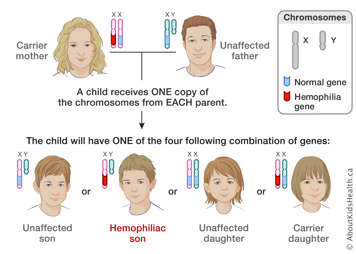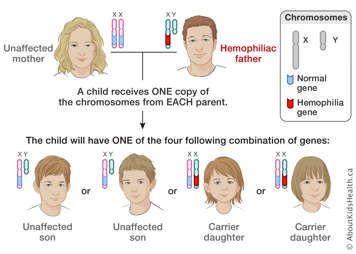Each of us inherits genetic material called deoxyribonucleic acid (DNA) from our parents. DNA is made of segments of genes, and is organized into chromosomes. We have about 20 000 different genes organized into 23 pairs of chromosomes. We get one of each chromosome from each of our parents. Our genes influence the way we look, our personalities, and our health. Our genetic code contains recipes for making proteins. These proteins help our bodies to work properly.
When there is a change in the genetic code, it can interfere with the body's ability to work normally. These changes in your genetic code are called mutations.
Mutations in certain clotting factors cause hemophilia
Hemophilia occurs when there is a mutation in one of the genes that control the production of a clotting factor. Since there are many clotting factors, each factor is numbered. Mutations in the gene that codes for factor 8 cause hemophilia A; mutations in the gene that codes for factor 9 cause Hemophilia B. These clotting factors are made by your liver. However, these mutations can make it difficult for your liver to produce sufficient amounts of clotting factor that your body needs.
Hemophilia mutations are inherited
Hemophilia is a genetic disease that is often inherited, meaning that it can be passed on through a person’s genes. We have special chromosomes that determine our sex, called the X and Y chromosomes. As mentioned above, changes in genes that code for factor 8 or factor 9 cause hemophilia. These genes are located on the X chromosome. Females have two X chromosomes, but males have one X chromosome and one Y chromosome. For this reason, females with hemophilia need two copies of this changed gene; males only need one.


This is why hemophilia is more prevalent in males than in females.







